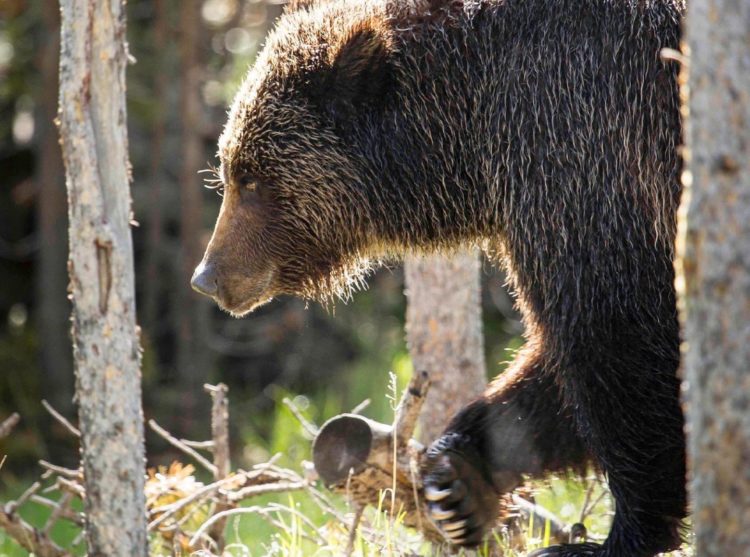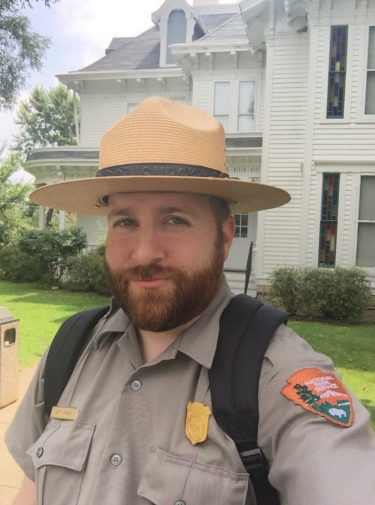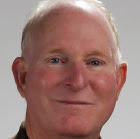
Do not immediately drop to the ground and “play dead.” Bears can sense overacting.
Do not run up and push the bear and do not push a slower friend down…even if you feel the friendship has run its course.
I was reminded of that post in mid-August at the terminus of the venerated Pacific Crest Trail in British Columbia, Canada. As I trudged into E.C. Manning Provincial Park I turned to my right — where a juvenile black bear stared at me from 15 feet away. Fortunately, the yearling was more interested in stuffing its face with brittle brush than with me. I slowly backed away while talking loudly, following the National Park Service’s PSA. Parks Canada offers similar information but in a just-the-facts format.
After returning from the close encounter, I tracked down the creator of the waggish posts to learn how a U.S. federal agency got so funny while still being smart. That’s where I found Matt Turner. For the past five years he has been part of the social media team at the park service headquarters in Washington D.C. and writes many of those surprisingly non- bureaucratic posts.
Examples: In an effort to captivate its 6.6 million followers, the National Park Service’s social media team posted two entries on Aug. 29 that mentioned bears. One read: “Hike in groups. Bears like to have options.” Without patronizing its readership, that started a breezy message about why it is safer to hike with others. Another post claimed: “Mondays can be un-bear-able!” That ran with an adorable image of a big brown bear at Lake Clark National Park & Preserve in Alaska and led to an entertaining and educational entry not about the danger bears pose, but about their cubs, dens, feeding habits and, yes, taxes. From that post:
For your educational moment, did you know bear cubs stay with their mothers for 2-3 years before venturing out on their own to find a job and a moderately priced den for rent? During that time, they learn important survival skills such as fishing, hunting, doing their taxes, clamming, foraging for berries, and sedge munching.
Help keep this coastline wild by respecting a bear’s food sources. Do not monopolize feeding sites, or displace bears from the sedge meadows, clam beds, and prime fishing holes.
Image: A bear at Lake Clark National Park & Preserve with its head covered by paws, most likely after finding out there are more forms to complete. NPS / A. Jones
In an era of diffuse media competing for eyeballs, the park service has waded into social media with a winning formula of playful content anchored by amusing photos. Rangers at Alaska’s Denali and Katami National Parks & Preserves have created a fun campaign with their annual Fat Bear Week that will be held Oct. 5-11, just as the big beasts head into winter hibernation. People can vote online to pick which one will emerge in the spring as Alaska’s fattest bear. Katami also offers a live webcam of its famous Brooks River grizzly bears.
Turner is on the team that writes catchy content for the agency’s official accounts. He also helps design posters and graphics, including one particularly clever image in 2020 featuring social distancing.
“Matt has a great eye for what the audience is going to want to hear and what they are going to want to know,” Cynthia Hernandez, a park service spokeswoman, told me.

Matt Turner
Turner spent almost two decades with the National Park Service after starting as a summer intern in 2005 at Fort Pulaski National Monument while studying in Savannah, Georgia. He earned a bachelor’s degree in history and anthropology from Texas Tech University in 2004 and a master’s degree focused in public/applied history from Armstrong State University in Savannah in 2008. He worked at the national historic sites of presidents Abraham Lincoln and Harry S. Truman giving tours and performing living history.
“It was a gradual rise from being in our parks up to being in headquarters,” he said. “I still think of myself as an interpreter.”
Turner talked to Storyboard about the process of creating G-rated humor and how his career has evolved into helping the park service win three Webby Awards this year that recognize excellence in digital and online communications. The conversation has been edited for length and clarity.
What is your writing background?
I’m a history major so I am always collecting stuff and reading and writing. Social media is a different kind of element because it is all about being concise in a lot of ways, or like being a reporter and getting that first sentence out there to get people’s attention. I look at a lot of our written resources on our websites. A lot of good material is already there that we can rearrange, repackage. I like to throw in a lot more of our personality and some humor here and there.
Historians generally write academic papers. How did you come to comedic writing?
It’s a mix of having that straightforward National Park Service persona — we want to be respected and looked at as an authority — then instilling it in dry wit. I don’t like to go overboard. I like to see if people connect with the reference— throwing in things here and there that I think surprises people. I try to use a lot of different references from a lot of different eras, generations and things that have lasted. Not just what happened last week, but some of those memes that have been around for a long time.
But how did you learn to do that? Were you a class clown?
I’ve always been someone who is watching and listening and paying attention. It’s almost like a monologue about the world around us. When I look at a picture or a subject that we want to post about, I think about it through a visitor’s eyes. I started out my career working in a booth handing out brochures and dealing with some interesting visitors. Pulling some stories and those memories helps me with my approach.
Is there an alchemy to picking the right subject for social media?
I’ll definitely look to see if I think there is something the public would like to learn more about. Or is there is visitor encounter or visitors’ questions about what is happening with certain species or animals? That might be a good time to see what Denali National Park is posting and how we can expand on that. Maybe add a twist.
Do you get your own research time in the parks?
I’m based in D.C. managing the national flagship account, which allows us to pool from all the different parks and programs. With over 400 parks there are lots of great stories, a lot of cool imagery we can rely on. I rely a lot on our websites. We have a whole site on bears themselves.
Do the local park rangers give you tips? Or does something hit you that you think is worth pushing out on social media?
A lot of it is curating content that the parks are putting out there and seeing what we can elevate, what is of interest to the general public. There are some great rangers in Denali and Katmai.
It’s a new age of information delivery. Do you check other websites or newsletters for ideas or inspiration?
Social media is always evolving. We have to evolve with it. Sometimes you can’t be over this many characters or you should never write this long. I just dive in. I don’t mind writing a couple paragraphs or creating something that I think might be engaging to the public even if it doesn’t match with what everybody else is sharing.
In general, I’m always looking at what other parks are posting and at other government agencies and places that have similar aesthetics to see how they are addressing some of their subjects in ways that I find interesting or that we can incorporate.
There are more than 400 national parks. How do you include them all?
People forget we have so many parks. They focus on just the big ones. We have so many rich stories. Social media has been a great way to showcase those underrated places. We all love Yellowstone and the Grand Canyon. But a lot of our parks focus on history or cultural sites. Fort Pulaski National Monument is a great story on architectural construction. There are so many parks like that that have so many different layers of history built into them.
What’s your favorite park?
That’s always a tough question. I worked in our midwest region based in Omaha. I had the opportunity to go up to South Dakota so I say the Badlands and Wind Cave are some of my favorites. Certainly the openness on the surface. We have that mix of history and wildlife — the bison.
You’re handling a major brand. Who edits you? How much leeway do you have?
I work with other public affairs specialists and PIOs. We work on posts with public policy. We go through a review process. It’s nice to have another set of eyes to go through things and make sure all the links are correct. For some of the day-to-day stuff, I have a little more leeway to post. A lot of that is being pulled from our vetted sources on nps.gov. If we see something cool that comes up we can reshare that. We just want to make sure we’re putting out quality information and correct information. We want to make sure all the stats and facts are right. People look at the National Park Service as a trusted resource.
It sounds as if NPS executives are not second-guessing everything you create. Is that right?
Yeah, that allows for more openness and willingness to push things out. We use humor a lot. Humor is subjective, so it’s a fine line. I’ll throw in a pun here and there just to see if people are paying attention. Keeping it family-friendly and wholesome is our goal. We want to be held up to those standards. We want to show a little bit of personality and throw in some sass here and there. But we all want to be in on the joke and we want everyone to come to our posts and pages and enjoy the experience.
The photo captions are one of the highlights of your work. Do you get an idea and assign a photo from someone in the field? Or do you find a photo someone took at a park and go from there?
Lots of great images are coming out of the parks or being shared on their websites. Sometimes you see something and it just makes a connection with something in pop culture or something that is going on in the world. You’re thinking, “How can I use that image to line up with the messaging that I want to put?” Sometimes it is the opposite. We have an idea for the the message and it is trying to find that perfect visual to complement it. We rely a lot on our staff in the field. They are taking the pictures as part of their daily routine of walking through the park.
How do you envision the voice and goal of the posts?
The goal always is to inform and provide an educational component. Not every post can be funny or humorous. It often starts with an interesting caption or quote we pull from the world around us to maybe surprise people. We are finding people are reading all the way through — they don’t want to miss anything.
How do you strike a balance between humor and seriousness? Parks are under a lot of stress with overcrowding, climate changes and wildland fires.
Humor is used sparingly. It works for a lot of different things we’re talking about. The main park service page is a virtual welcome center. So we’re inviting people to learn about their parks. But a lot of our parks deal with very difficult situations: They are places for learning and healing. It is not a time to be funny or flippant. Parks also are places to learn about who you are, and where we come from and where we are going.
***
Elliott Almond worked as a sports reporter at the San Jose Mercury News and Seattle Times, using sports as a vehicle to write about the human condition. He now writes for the Cascadia Daily News in Bellingham, Washington, and hikes the mountains of the Pacific Northwest.


